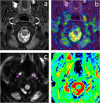Arterial spin labeling and diffusion-weighted imaging for identification of retropharyngeal lymph nodes in patients with nasopharyngeal carcinoma
- PMID: 35978445
- PMCID: PMC9387018
- DOI: 10.1186/s40644-022-00480-4
Arterial spin labeling and diffusion-weighted imaging for identification of retropharyngeal lymph nodes in patients with nasopharyngeal carcinoma
Abstract
Background: To evaluate the parameters derived from arterial spin labeling (ASL) and multi-b-value diffusion-weighted imaging (DWI) for differentiating retropharyngeal lymph nodes (RLNs) in patients with nasopharyngeal carcinoma (NPC).
Methods: This prospective study included 50 newly diagnosed NPC and 23 healthy control (HC) participants. RLNs of NPC were diagnosed according to the follow-up MRI after radiotherapy. Parameters derived from ASL and multi-b-value DWI, and RLNs axial size on pre-treatment MRI among groups were compared. Receiver operating characteristic curve (ROC) was used to analyze the diagnostic efficiency.
Results: A total of 133 RLNs were collected and divided into a metastatic group (n = 71) and two non-metastatic groups (n = 62, including 29 nodes from NPC and 33 nodes from HC). The axial size, blood flow (BF), and apparent diffusion coefficient (ADC) of RLNs were significantly different between the metastasis and the non-metastasis group. For NPC patients with a short axis < 5 mm or < 6 mm, or long axis < 7 mm, if BF > 54 mL/min/100 g or ADC ≤ 0.95 × 10-3 mm2/s, the RLNs were still considered metastatic. Compared with the index alone, a combination of size and functional parameters could improve the accuracy significantly, except the long axis combined with ADC; especially, combined size with BF exhibited better performance with an accuracy of 91.00-92.00%.
Conclusions: ASL and multi-b-value DWI could help determine the N stage of NPC, while the BF combination with RLNs size may significantly improve the diagnostic efficiency.
Keywords: Diffusion magnetic resonance imaging; Magnetic resonance imaging; Nasopharyngeal neoplasms; Perfusion imaging.
© 2022. The Author(s).
Conflict of interest statement
The authors declare that they have no competing interests.
Figures





Similar articles
-
Comparison of four MRI diffusion models to differentiate benign from metastatic retropharyngeal lymph nodes.Eur Radiol Exp. 2025 May 13;9(1):50. doi: 10.1186/s41747-025-00590-1. Eur Radiol Exp. 2025. PMID: 40358858 Free PMC article.
-
Diffusion-weighted imaging to differentiate metastatic from non-metastatic retropharyngeal lymph nodes in nasopharyngeal carcinoma.Dentomaxillofac Radiol. 2015;44(3):20140126. doi: 10.1259/dmfr.20140126. Epub 2014 Nov 28. Dentomaxillofac Radiol. 2015. PMID: 25430557 Free PMC article.
-
Investigating the value of arterial spin labeling and intravoxel incoherent motion imaging on diagnosing nasopharyngeal carcinoma in T1 stage.Cancer Imaging. 2020 Aug 28;20(1):62. doi: 10.1186/s40644-020-00339-6. Cancer Imaging. 2020. PMID: 32859273 Free PMC article.
-
Combination of diffusion-weighted imaging and arterial spin labeling at 3.0 T for the clinical staging of nasopharyngeal carcinoma.Clin Imaging. 2020 Oct;66:127-132. doi: 10.1016/j.clinimag.2020.05.007. Epub 2020 May 15. Clin Imaging. 2020. PMID: 32480267
-
Diffusion tensor imaging parameters for the early diagnosis of radiation-induced brain injury in patients with nasopharyngeal carcinoma: a meta-analysis.Int J Radiat Biol. 2024;100(3):335-342. doi: 10.1080/09553002.2023.2280010. Epub 2024 Jan 16. Int J Radiat Biol. 2024. PMID: 37934054 Review.
Cited by
-
T1 and T2 mapping for identifying malignant lymph nodes in head and neck squamous cell carcinoma.Cancer Imaging. 2023 Dec 17;23(1):125. doi: 10.1186/s40644-023-00648-6. Cancer Imaging. 2023. PMID: 38105217 Free PMC article.
-
Comparison of four MRI diffusion models to differentiate benign from metastatic retropharyngeal lymph nodes.Eur Radiol Exp. 2025 May 13;9(1):50. doi: 10.1186/s41747-025-00590-1. Eur Radiol Exp. 2025. PMID: 40358858 Free PMC article.
-
Performance of axial diameter on MR imaging for identification of retropharyngeal lymph node metastases in head and neck cancer: a systematic review and meta-analysis.Neuroradiology. 2023 Sep;65(9):1363-1369. doi: 10.1007/s00234-023-03205-x. Epub 2023 Jul 31. Neuroradiology. 2023. PMID: 37522935
References
MeSH terms
Substances
LinkOut - more resources
Full Text Sources
Miscellaneous

